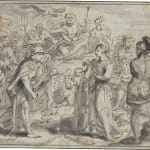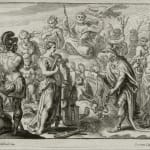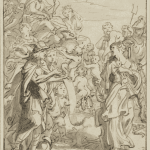
Cornelis van Caukercken after Abraham van Diepenbeeck, Pax Optima Rerum (1659).
Stadsarchief Turnhout, inventory number P02916.

Abraham van Diepenbeeck, Preliminary design for Pax Ultima Rerum.
KBR, Brussels, inv. no. F 15185.
Abraham van Diepenbeeck ('S-HERTOGENBOSCH 1596 - 1675 ANTWERPEN)
Further images
Although apparently not indented for transfer to the engraver's plate, the subject, format and scale of the present work all indicate that it was made as a design for a print. In the foreground it shows Hermes holding up a sheet, presumably for one of the muses, in the presence of an assembly of Olympic gods. While the inscription on the sheet is illisible, it used to be interpreted as sheet music, the scene thus depicting an allegory of music; however, the drawing can be connected to an engraving made as an illustration for Joos Lambrecht's Vlaemsche vrede-vreucht naer een pijnelijcke droefheyt door den grouwelijcken oorlogh, nu verandert in een aengenaeme peys (1659) (see ill. 1), which allowed for the iconography to be definitively deciphered. The inscription on the print reads "PAX OPTIMA RERUM", as it refers to the peace declaration between the kings of Spain and France (made before all the gods in heaven), which was signed in 1659, ending the Franco-Spanish war (1635 - 1659). A first draft of the composition, also by van Diepenbeeck, is kept in the Royal Library, Brussels (inv. no. F 15185; see ill. 2).
Provenance
Pierre Jean Mariette (1694 - 1774), Paris (L. 1852);
Sotheby's Amsterdam, 12 November 1996, lot 41;
Wieg Collection, Amsterdam.
- X
- Tumblr
-
 Abraham van Diepenbeeck ('s-Hertogenbosch 1596 - 1675 Antwerp)King Priam visiting Achillespen and brown ink over black chalk, grey washes and white gouache highlights; incised for transfer260 x 200 mminscribed 'Diepenbeeck.' on the chair
Abraham van Diepenbeeck ('s-Hertogenbosch 1596 - 1675 Antwerp)King Priam visiting Achillespen and brown ink over black chalk, grey washes and white gouache highlights; incised for transfer260 x 200 mminscribed 'Diepenbeeck.' on the chair -
 Abraham van Diepenbeeck ('s-Hertogenbosch 1596 - 1675 Antwerp)The Adoration of the Shepherdspen and brown ink over black chalk109 x 84 mm
Abraham van Diepenbeeck ('s-Hertogenbosch 1596 - 1675 Antwerp)The Adoration of the Shepherdspen and brown ink over black chalk109 x 84 mm -
 Abraham van Diepenbeeck ('s-Hertogenbosch 1596 - 1675 Antwerp)A Sacrificial Sceneblack chalk on paper214 x 122 mm
Abraham van Diepenbeeck ('s-Hertogenbosch 1596 - 1675 Antwerp)A Sacrificial Sceneblack chalk on paper214 x 122 mm -
 Abraham van Diepenbeeck ('s-Hertogenbosch 1596 - 1675 Antwerp)The Assumption of the Virginblack chalk, pen and brown ink on laid paper170 x 140 mm
Abraham van Diepenbeeck ('s-Hertogenbosch 1596 - 1675 Antwerp)The Assumption of the Virginblack chalk, pen and brown ink on laid paper170 x 140 mm







